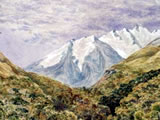What happened that day?
See historic events for any day of the year by entering the date below. Why not try your birthday?
Kiwi of the Week
Today in History

1863 Haast begins West Coast expedition
Canterbury Provincial Geologist Julius von Haast led an exploratory expedition in search of a route from the east to the west coast of the South Island. The expedition ‘discovered’ a suitable route at the headwaters of the Makarora River.
Along the way they also revealed the extent of the Grey River coalfields and reported traces of gold in West Coast rivers. Although the prospector Charles Cameron is said to have been the first European to ‘discover’ the pass, Haast was rewarded by having it named after him. Haast and his expedition reached the pass on 23 January, crossed it and travelled downstream to the coast, where they arrived on 20 February.
The European exploration of the New Zealand interior was a long process. The surveying of inland areas was fundamental to European settlement, defining the boundaries of ownership, and identifying resources, useable land and access routes. Surveying and exploration were part of the British colonial vision to claim, tame and name the landscape. European explorers and surveyors viewed the landscape as empty and available. They travelled New Zealand rediscovering territory known to Maori for generations, transplanting familiar names of places from Britain and Europe as they went.
As settlements became more established, the attention of surveyor-explorers increasingly turned to the identification of hinterlands and routes for the transportation of goods. The European discovery of transalpine routes in the 1850s and 1860s opened up new areas for settlement. In the South Island, the search for more land for sheep-runs was one of the primary drivers for exploration.
As the pursuit of gold spread from Otago to the West Coast in the late 1850s and early 1860s many sought new passages through the seemingly impassable gorges and impenetrable bush of the region.
The last great wave of European exploration in New Zealand was undertaken in the 1860s in the name of pure science. Men such as Ernst Dieffenbach, Julius von Haast, Ferdinand von Hochstetter and Andreas Reischek covered much of the country, mapping its geology on a scale not previously seen. As Canterbury Provincial Geologist from 1860, von Haast conducted a number of comprehensive surveys of the province, sprinkling Germanic names over the landscape as he went.














